Diplomatic Bluebook 2016
Chapter 2
Japan’s Foreign Policy that Takes a Panoramic Perspective of the World Map
2.China/Mongolia, etc.
(1) China
A. The Situation in China
(a) Economy
The Chinese economy has been gradually slowing down. In 2015, the real GDP growth rate showed an increase of 6.9% and total trade value fell 8.0% over the previous year (total import value in particular fell 14.1% over the previous year). On the other hand, the ongoing business trends vary greatly among regions and industries. By industry, for instance, while the secondary industry including manufacturing is slowing down, the tertiary industry such as finance and services is growing steadily.
Turning to financial trends, there occurred rapid changes, such as volatile stock price fluctuations in the Shanghai stock market, and the weakening tendency of the renminbi over 6% against the U.S. dollar toward the end of the year, due to a change in the quotation of the central party of Renminbi in August 2015 (In late November of the same year, the International Monetary Fund (IMF) decided to incorporate the renminbi into the special Drawing rights (SDR) basket currencies. The application is scheduled for October 2016.), leading to an increasing concern about the outlook for the Chinese economy, coupled with the slowdowns in various economic indicators.
Ensuring stable growth of the economy is a foundation of stable society and the source of Chinese people’s support for the Communist Party of China, the ruling party. However it has become more complex and more difficult than ever before, with the background of reduced competitiveness, the negative legacy from the past rapid growth and the aftereffects of four-trillion-yuan-stimulus package.” Under these circumstances, the Chinese Communist Party and Chinese government regard the current situation of the Chinese economy as the “new normal.” It aims to ensure a transformation in economic development model from the conventional high-speed growth led by investment and exports to mid- to high-speed growth led by consumption and domestic demand through structural reforms from a mid- to long-term perspective while securing sustainable and stable growth by economic stimulus measures from a short-term perspective.
At the 5th plenary session of the 18th Central Committee held in October 2015, a proposal concerning the 13th five-year plan (2016-2020) was discussed and adopted, in which innovation and openness were positioned as the pillars of economic policy. In addition, General Secretary Xi Jinping clearly stated that, to achieve the conventional goal of doubling GDP and per capita income in 2020 as compared with 2010, the bottom line of the average annual growth rate during the period of this plan will be 6.5% or more. At the Central Economic Work Conference held in December of the same year, while showing a willingness to prop up the economy through fiscal policy as a basic economic policy in 2016 and the following certain period, the Chinese government is determined to put emphasis on elimination of excess capacity and housing inventory and the supply-side structural reform through improving productivity. It is to be noted to what extend can China implement the mid-to-long term reforms with overcoming short-term pain included in the next five-year plan to be determined at the National People’s Congress scheduled in March 2016.
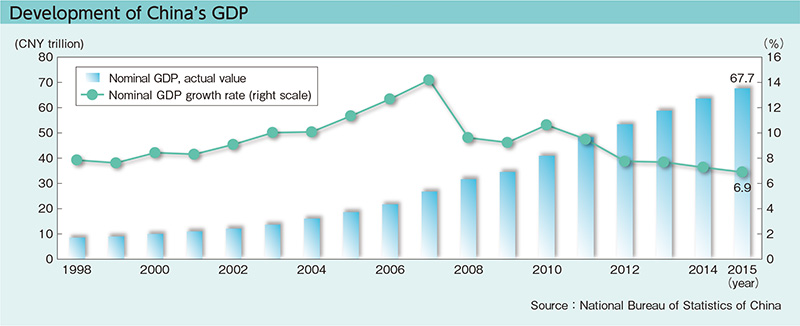
(b) Domestic affairs
While the economic growth is slowing down, a variety of social issues have emerged to serious levels, such as wealth disparity, environmental pollution, the spread of corruption and intensification of ethnic minority problems. The Xi Jinping leadership, after setting a target of “overall deepening of reform” and “rule of law” at the Third Plenary Session in 2013 and the Fourth Plenary Session in 2014 of the Central Committee, respectively, discussed the 13th Five-Year Plan (development plan from 2016 to 2020), the first five-year plan under the Xi Jinping regime, at the Fifth Plenary Session of the 18th Central Committee, and clearly showed the attitude to commit to tackling various problems.
The anti-corruption movement strongly promoted since the inauguration of the Xi Jinping regime continuously performed in 2015 as well. Deprivation of party membership and public position as well as disposal by a judicial institution was decided on in June for Zhou Yongkang (a member of the Party Central Political Bureau Standing Committee under the former Hu Jintao leadership), against whom a prosecutable case had been built in July in the previous year, and revocation of party membership was announced in July for Guo Boxiong, who was the highest-ranking military officer in the People’s Liberation Army (former Central Military Commission Vice Chairman). Furthermore, interrogations targeting high-ranking local officials were also announced one after another in December, such as of the Shanghai Vice-Mayor and the Deputy Secretary of the Beijing Municipal Communist Party Committee.
On September 3, a military parade was carried out in Tiananmen Square for the first time in six years. Traditionally, a military parade used to be carried out on Chinese National Day (October 1) every 10 years commemorating the founding of the country (1949) but, in 2014, it was held on September 3, which was newly enacted as a “National anniversary celebrating victory in the Japanese war.” In terms of social environment, values in Chinese society are becoming increasingly diverse, due to an increasing population of Internet users. Against this backdrop, the tendency to newly strengthen pressure inside China, based on the “National Security Law,” is increasingly observed, and the restraint of a large number of human rights activists and lawyers was reported on in July. In addition, Mr. Pu Zhiqiang, a human rights lawyer, was convicted in December, for which concern about the human rights situation in China was voiced in the international community. Deeply-rooted dissatisfaction of the Tibetan and Xinjiang groups against the authorities is also in existence.
(c) Foreign policy
In 2015, active moves were seen in foreign affairs. Proactive economic diplomacy was deployed in light of the initiative entitled “One belt, one road (Silk Road Economic Belt/21st Century Maritime Silk Road)” proposed by President Xi Jinping in 2013, with emphasis on infrastructure exports including high-speed railway. The first general assembly of BRICS (emerging five countries: Brazil, Russia, India, China, and South Africa) Development Bank (Headquarters: Shanghai) was held in July, and the establishment agreement of Asian Infrastructure Investment Bank (AIIB) came into force in December, whereby a China-led international development financial institution is expected to start in a full-fledged manner.
On the other hand, attempts by China to unilaterally change the status quo, such as land reclamations, building outposts and their use for military purposes in the South China Sea, have caused great friction among neighboring countries (see 1-1 (2), 2-1-6 and 3-1-3 (4)). In September, President Xi Jinping visited the U.S. as a state guest and held a summit meeting with President Obama. At the ensuing joint press conference, President Xi Jinping stated, “There is no intention to pursue militarization.” Since October, the “Freedom of Navigation” operations have been intermittently carried out by the U.S. forces, and China’s response is drawing attention.
In order to fully realize a “well-off society (a society enabling people to enjoy leisure to some extent)” by 2020, it is believed that China will aim to create a more favorable external environment. Increasingly of note is how a China that is expected to continue to increasingly strengthen economic power is going to deploy diplomacy in the future.
(d) Military affairs and security
China has continued to increase defense expenditures at a high level. The national defense budget also shows a high increase of 7.6% in 2016 as compared with the budget amount implemented in the previous year. However, no explanation has been given on the breakdowns of expenditure, and the intention to increase was not disclosed, either. Under such circumstances, the nuclear and missile capabilities and military power centered on naval and air forces are assumed to be enhanced extensively and rapidly in recent years. For instance, the Ministry of National Defense of People’s Republic of China formally announced the commission of their first aircraft carrier “Liaoning” in 2012. In December 2015, they announced that a second aircraft carrier is under construction in China.
Furthermore, unilateral activities by the Chinese military in the sea and airspace around Japan are on the increase, such as the setting of “Air Defense Identification Zone (ADIZ) in the East China Sea” in November 2013 and repeated navigation by Chinese Navy intelligence gathering vessel outside of the contiguous zone around the Senkaku Islands in November 2015.
Such broad and rapid expansion of military capability lacking transparency, and continued attempts to unilaterally change the status quo are common regional concern. Japan intends to strive to involve China in the international order based on the rule of law in cooperation with the countries concerned.
B. Japan-China relationship
(a) Circumstances surrounding the Japan-China relationship
Japan and China are neighboring countries across the East China Sea, and have close economic relations and people-to-people and cultural exchange. Thus the relationship is inseparable, and constitutes one of the most important bilateral relationships. At the same time, Japan and China have numerous political and social differences. Thus, it is inevitable to have friction and conflicts, precisely because two countries are neighbors. Japan and China agreed to build a “Mutually Beneficial Relationship Based on Common Strategic Interests” in 2006, based on the idea that it is important not to affect the entire relationship, even if there are specific issues. Since then, the leaders of the two countries have continued to repeatedly confirm that they will promote a “Mutually Beneficial Relationship based on Common Strategic Interests.”
In 2015, the Japan-China relationship was seen to tend toward improvement. After the summit meeting between Japan and China held in Beijing in November 2014, various dialogues and exchanges, which had been long stagnant until then, were resumed. In January 2015, a Japan-China security dialogue was held for the first time in about four years, enabling the two countries to exchange views on security policy, etc. In March, on the occasion of the foreign ministers’ meeting among Japan, China and the ROK held in the ROK, a foreign ministers’ meeting between Japan and China took place. At an event celebrating the 60th anniversary of the Bandung Conference held in April in Indonesia, the second summit meeting was held between Prime Minister Abe and President Xi Jinping. The two leaders of both Japan and China shared the recognition that Japan-China relations are heading toward improvement, and confirmed the mutual intention to continue to accumulate dialogues and exchanges at various levels, thereby ensuring the tendency of improving relations. Dialogue between the two governments continued to take place in the second half of the year. On the occasion of ASEAN-related foreign ministers’ meeting held in August in Malaysia, a foreign ministers’ meeting between Japan and China was held. In addition, State Councilor Yang Jiechi visited Japan in October, paid a courtesy visit on Prime Minister Abe and Chief Cabinet Secretary Suga, respectively. He also exchanged views with National Security Advisor Yachi. On the occasion of the Japan-China-ROK Trilateral Summit Meeting held in the ROK in November, Prime Minister Abe and Prime Minister Li Keqiang had the first summit meeting. A foreign ministers’ meeting also took place for the sixth time since August 2014. Through the talks, specific results were obtained, including the fact that the two leaders confirmed the resumption of mutual foreign ministers’ visits to each other and the importance of high-level exchanges, including between the foreign ministers. Furthermore, Prime Minister Abe had a standing conversation with Prime Minister Li Keqiang to conduct positive exchange on the occasion of an ASEAN-related summit meeting held in November, as he also did with President Xi Jinping on the occasion of the 21st session of the Conference of the Parties to the UN Framework Convention on Climate Change (COP21).
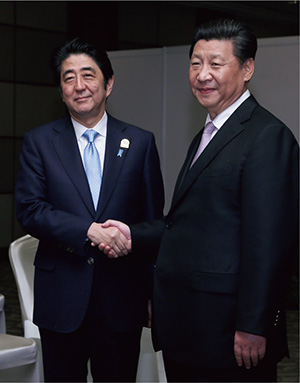 Japan-China summit meeting (April 23, Jakarta, Indonesia; Photo: Cabinet Public Relations Office)
Japan-China summit meeting (April 23, Jakarta, Indonesia; Photo: Cabinet Public Relations Office)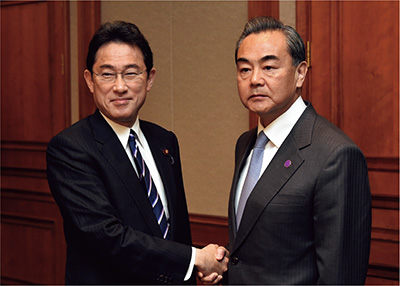 Japan-China foreign ministers’ meeting (November 1, Seoul, ROK)
Japan-China foreign ministers’ meeting (November 1, Seoul, ROK)While an improving tendency in relations is confirmed by the two countries at repeated high level contacts, there continue to be intrusions by Chinese Government-owned vessels into the territorial waters around the Senkaku Islands and unilateral resource development by China in the maritime area pending delimitation.
It was in December 2008 that an intrusion by a Chinese Government-owned vessel into the territorial sea around the Senkaku Islands first took place. In 2015, China dispatched government-owned vessels into the territorial waters around the Senkaku Islands almost every day, and repeated intrusions into the territorial waters 35 times (95 vessels in total). The Senkaku Islands are indisputably an inherent part of the territory of Japan in light of historical facts and based upon international law. Indeed, the Senkaku Islands are under the valid control of Japan. Consequently, there exists no issue of territorial sovereignty to be resolved concerning the Senkaku Islands. Since 1885, Japan had conducted repeated investigations and, having confirmed that there were no traces to suggest that the islands were under the control of the Qing dynasty, incorporated them into Japanese territory in January 1895. Subsequently, with the permission of the Government of Japan, numerous Japanese citizens settled on the Senkaku Islands, where they engaged in business activities such as the manufacture of dried bonito flakes. After World War II, the Senkaku Islands were placed under the administration of the U.S. by the San Francisco Peace Treaty. From 1895, when Japan obtained territorial title over the Senkaku Islands by lawful means under international law, until the 1970s, when the islands became the focus of attention after it was suggested that there might be oil reserves in the East China Sea, China did not raise any objections to Japan’s sovereignty over the Senkaku Islands1. Moreover, China has never explained why it had not expressed objections.
The Government of Japan will continue to deal with the situation with resolute determination to defend Japan’s territorial land, sea, and airspace. We have repeatedly used diplomatic channels to lodge strong protests and request the withdrawal of Chinese vessels.
With regard to the “Maritime and Air Communication mechanism between Japan-China defense authorities” to avoid unexpected situations, the two parties had discussions at the 4th and 5th joint working group meetings held in January and June 2015, and at the 3rd and 4th meetings for Japan-China High-Level Consultation on Maritime Affairs held in January and December 2015. Both Japan and China share the view to continue to have consultation for early start of operation of the mechanism.
Japan and China share responsibility for the peace and stability of the region and the entire international community. Stable Japan–China relations are essential not only to the citizens of both countries, but also to the peace and stability of the Asia-Pacific region as a whole. Accordingly, based on the concept of the “Mutually Beneficial Relationship based on Common Strategic Interests,” the Government of Japan will promote the development of Japan–China relations from a broad perspective through continued dialogues and cooperation at various levels.
- 1 It is confirmed that there exists a Chinese document created on the premise that the Senkaku Islands are part of Japanese territory in the 1950s and 1960s. The Ministry of Foreign Affairs has posted on its website a map published by China in 1969 attaching a title indicating the Senkaku Islands as part of Japanese territory, from which it is considered to have been created on the premise that the Senkaku islands belonged to Japanese territory.
(b) Current state of China’s unilateral resource development in the East China Sea
In recent years, China has accelerated its development activities of natural resources in the East China Sea. The Government of Japan has newly confirmed 12 structures since June 2013, and a total of 16 structures including those confirmed before then, on the Chinese side of the geographical equidistance line between Japan and China.
The Exclusive Economic Zone and the continental shelf in the East China Sea have not yet been delimited. Japan takes a position that maritime delimitation should be conducted based on the geographical equidistance line between Japan and China. In this regard, under the circumstances pending maritime boundary delimitation, it is extremely regrettable that China is advancing unilateral resource development. Every time China’s related moves are recognized, Japan has strongly requested China to cease its unilateral development and to resume negotiations as soon as possible on the implementation of the “June 2008 Agreement” in which Japan and China agreed to cooperate on the development of natural resources in the East China Sea. In July 2015, while deciding to publish relevant information in an appropriate manner, Japan posted on the Ministry of Foreign Affairs’ website a map indicating the position of the structure and related photos.
Considering it was concurred that Japan and China should aim to resume negotiations based on the “June 2008 Agreement” at a summit meeting between Japan and China held in November 2015, Japan will continue to strongly request China to resume negotiations immediately and implement the agreement as soon as possible. (see 1-1 (2), 2-1-6 and 3-1-3 (4)).
(C) Japan-China economic relations
Economic relations between Japan and China, including trade and investment, are close and interdependent. The total trade between Japan and China (excluding Hong Kong) amounted to about 270 billion US dollars in 2015, and China has been the largest trading partner for Japan for nine consecutive years. According to Chinese statistics, direct investment from Japan decreased to about 3,210 million US dollars in 2015, due to increased labor costs: down 25.9% over the previous year (estimated based on officially published investment values). By country, Japan ranks 3rd in terms of the amount of direct investment to China (Singapore ranks first, followed by the ROK).
In 2015, various types of dialogues and exchanges were carried out in the economic field. In March, Minister of Civil Affairs Li Liguo visited Japan to attend the UN World Conference on Disaster Risk Reduction (in Sendai), and met with Foreign Minister Kishida and others. It was the first time in about three years that a Chinese minister visited Japan. In April, Director of National Tourism Administration Li Jinzao visited Japan to attend a tourism ministers’ meeting among Japan, China and the ROK. Other minister-level dialogues included the Tripartite Environment Ministers Meeting among Japan, China and the ROK (in April, Shanghai, China), Japan-China financial dialogue (in June, Beijing, China) and Japan-China Energy Conservation and Environment Forum (November, Tokyo). With regard to Japan-China economic partnership talks in which high-ranking officials of relevant ministries and agencies get together from the two countries, a deputy director general level meeting was held in July for the first time in about four years, followed by a vice minister-level meeting held in December for the first time in about five and half years.
At these meetings, they exchanged views on bilateral and multilateral issues and cooperations. Economic exchanges at the private sector level were also actively carried out. A Japan-China tourism and culture exchange delegation, consisting of more than 3,000 tourism industry officials and stakeholders, visited China in May, and President Xi Jinping made a speech with emphasis on Japan-China relations at the “Evening of Japan-China friendship and exchange.” In November, the Japan-China Economic Association, Keidanren (Japan Business Federation) and Japan Chamber of Commerce and Industry jointly dispatched a delegation to visit China for the first time, having a meeting with Prime Minister Li Keqiang. In November, a group of entrepreneurs led by former Vice Prime Minister Zeng Peiyan visited Japan, and attended the 1st Japan-China CEO dialogue in Tokyo.
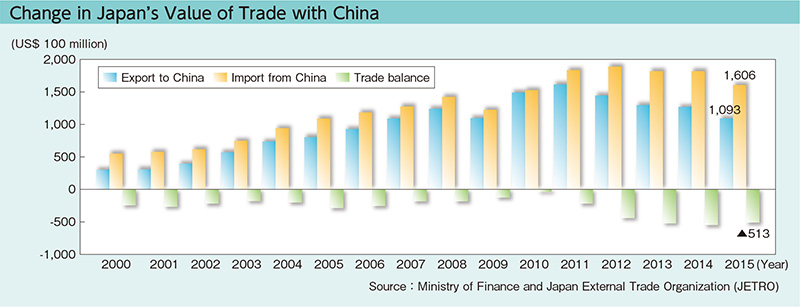
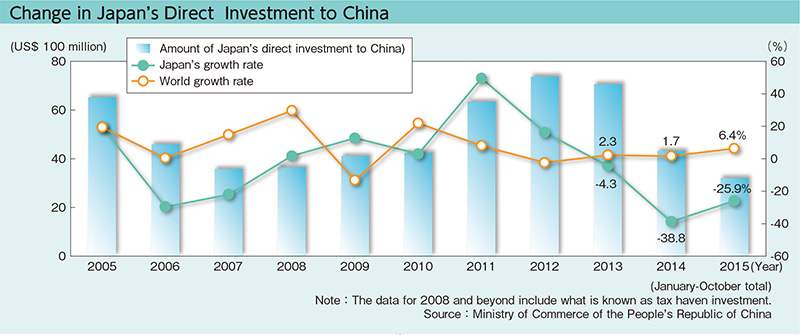
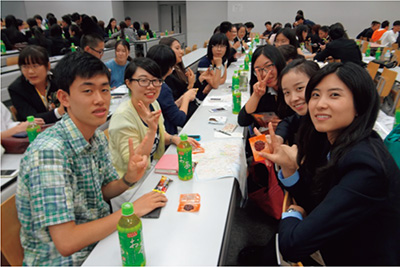 A delegation of Chinese university students visiting Japan No. 22 group (September 13-20; Photo: Japan-China Friendship Center)
A delegation of Chinese university students visiting Japan No. 22 group (September 13-20; Photo: Japan-China Friendship Center)On the working-level, various dialogues took place, including the 16th Japan-China Fisheries Joint Committee (July, Tokyo) and Japan-China governmental negotiations for Agreement on Social Security organized for the first time in about three and a half years (November, Tokyo).
(d) Promotion of mutual understanding between Japanese and Chinese people
(Current situation of people-to-people exchanges between Japan and China)
A total of about 7.49 million people took part in people-to-people exchanges between Japan and China in 2015 (about 5.13 million people in 2014). The total number of Chinese visitors to Japan set a record high of about 4.99 million (up 107% over the previous year), and their vigorous willingness to purchase attracted attention with the term “bakugai (buying rush).” The total number of Japanese visitors to China fell 220,000 to 2.5 million (down 8% over the previous year).
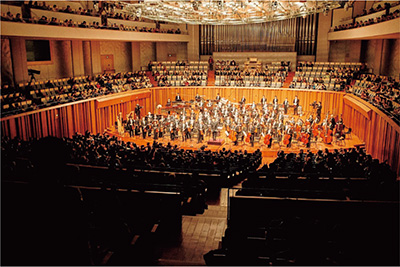 NHK Symphony Orchestra’s performance from Beijing performances (October 31, Beijing, China; Photo: Dentsu)
NHK Symphony Orchestra’s performance from Beijing performances (October 31, Beijing, China; Photo: Dentsu)(Japan-China youth exchange)
In 2015, Japan invited a total of about 3,500 Chinese high school and university students and others in the program “JENESYS (Japan-East Asia Network of Exchange for Students and Youths) 2.0” with China. Chinese young people that visited Japan felt Japan brands of its attractiveness and strengths including “Cool Japan” through school exchanges and tours to businesses, while they deepened a mutual understanding with Japanese youth, and the youth from the two countries discussed what the future Japan-China relationship should be.
(Exchanges in various fields)
To further develop Japan-China relations, the Government of Japan invites people at various levels in all walks of life to Japan, such as leaders of central and local governments in China, people having certain influence in the political, economic, public and academic sectors, and next-generation leaders and opinion leaders in addition to young people who will carry the next generation, such as high school students, thereby making efforts for a wide range of relationship building and strengthening. The Chinese participants are expected to exchange views with various circles and experts and go on inspection tours, hoping that a good relationship will be built between the invitees and Japanese parties concerned and Japan will be more accurately understood through these exchanges. The Embassy of Japan in China carried out a contest to recruit written descriptions of impressions and photos on travels to Japan from May to June and from October to December of 2015 on a social networking site (SNS), gathering high interest. The number of views on the posting page reached 35 million.
Kabuki performances were also carried out in Beijing in April. Furthermore, during a period from October to November in 2015 referred to as an “Intensive Month for Japan-China Exchanges,” a variety of Japan-China exchange events took place intensively mainly in Beijing (Japanese drum YAMATO Beijing performance (October 13-14), NHK Symphony Orchestra Beijing concert (October 31) and Seri Yoko four seasons’ songs Beijing performance by Yoko Seri commemorating the visit to China for Japan-China friendship (November 13), etc.).
(e) Abandoned chemical weapons issue
The Government of Japan, according to the Chemical Weapons Convention (CWC), has been working on the disposal of abandoned chemical weapons in China, making steady progress as follows: Disposal by mobile processing facilities has been being carried out in Shijiazhuang City, Hebei and in Wuhan City, Hubei; test disposal is proceeding at Haerbaling District in Dunhua, Jilin Province; disposal was completed in Wuhan City in July 2015, and; disposal of about 39,000 abandoned chemical weapons is to be completed before the end of 20152.
- 2 With regard to chemical weapons abandoned by the Imperial Japanese Army in the area of China, about 53,000 shells have been confirmed in a wide range extending from northern Heilongjiang to southern Guangdong Province, and it is estimated that about 300,000-400,000 shells are buried in the Haerbaling District, Jilin Province. The Government of Japan is conducting field surveys jointly with the Chinese government, and is proceeding with scrap and disposal projects as well as excavation and recovery operations in various parts, under the cooperation with the Chinese government.
(2) Taiwan
A. Internal Affairs
Taiwan held a presidential election and Legislative Yuan elections in January 2016. While the ruling Kuomintang changed its presidential candidates, the opposition Democratic Progressive Party continued to be dominant during the campaign. Tsai Ing-wen, Chairperson of the Democratic Progressive Party was elected in the presidential election. The Democratic Progressive Party also won its outright majority in the Legislative Yuan elections for the first time. Accordingly, the ruling party is set to be replaced by the opposition party for the first time in eight years.
The economy showed weakness, reflecting a fall in exports. The real GDP growth rate slowed-down to 1.06% (preliminary figure) in 2015 over the previous year.
B. Cross-strait Relations and Foreign Affairs
On November 7, President Xi Jinping of China met with President Ma Ying-jeou of Taiwan in Singapore. It was for the first time since 1949 that a summit meeting between China and Taiwan was held. Japan, as a consistent stance, hopes that the issue surrounding Taiwan will be resolved peacefully by direct dialogue between the concerned parties, and expressed the idea of continuing to watch the development of the situation in the hope that the moves mentioned above will contribute to the peace and stability of the region.
1. History of the Japan-China-ROK Trilateral Summit Meeting ~ the Trilateral Summit Meeting came into being in Japan ~
On December 13, 2008, Prime Minister Taro Aso of Japan invited Premier Wen Jiabao of State Council, China, and President Lee Myung-bak of the ROK to Fukuoka and hosted the first Japan-China-ROK Trilateral Summit Meeting.
It was not the first time to hold the Japan-China-ROK leaders’ meeting. During the period from 1999 to 2007, Japan-China-ROK leaders’ meetings had taken place in association with ASEAN+3 Summit Meetings. Accumulating Japan-China-ROK leaders’ meetings, ministerial meetings and working-level experts’ meetings came to be held in each area to follow or embody the outcomes of the leaders’ meeting.
Based on these achievements, momentum was enhanced toward holding Japan-China-ROK Trilateral Summit Meeting independently, instead of on the margin of ASEAN + 3 Summit Meetings held in ASEAN Member States. The first Japan-China-ROK Trilateral Summit Meeting was held in Fukuoka, Japan, in December 2008.
Afterwards, Japan-China-ROK Trilateral Summit Meetings were held every year in the order of Japan, China and the ROK up to 2012, where the leaders conducted lively face-to-face discussions to achieve full cooperation in an increased number of areas on the basis of the achievements of the cooperation that had accumulated since 1999.
The practice was established as well whereby the Japan-China-ROK Foreign Ministers’ Meeting was also held prior to the Trilateral Summit Meeting to undertake all possible preparations for discussions at the Trilateral Summit Meeting. In 2015, the Japan-China-ROK Foreign Ministers’ Meeting was held in March for the first time in three years, prior to the Japan-China-ROK Trilateral Summit Meeting, which is still vivid in our mind.
2. Japan-China-ROK Trilateral Summit Meeting in 2016 ― chairmanship to be taken by Japan
The Japan-China-ROK Trilateral Summit Meeting held in 2015 for the first time in approximately three and a half years, was meaningful in the following senses: (1) the three leaders shared the view that trilateral cooperation had been completely restored, (2) they reaffirmed that the Trilateral Summit should be held on a regular basis, and (3) they decided that Japan would take chairmanship. For Japan, the year 2016 will be a year when it hosts the Japan-China-ROK Trilateral Summit Meeting for the third time. We aim for a Trilateral Summit Meeting with meaningful achievements in a wide range of areas, including economy, environment and youth exchange. Through these efforts, we intend to fulfill responsibilities for peace and prosperity in the region, shared among Japan, China and the ROK.
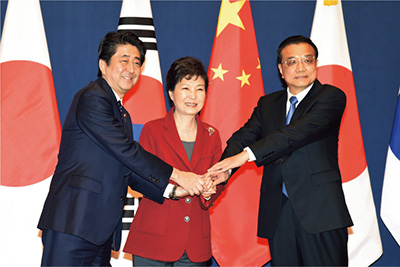 The Japan-China-ROK Trilateral Summit Meeting
The Japan-China-ROK Trilateral Summit Meeting(November 1, Seoul, Korea; Photo: Cabinet Public Relations Office)
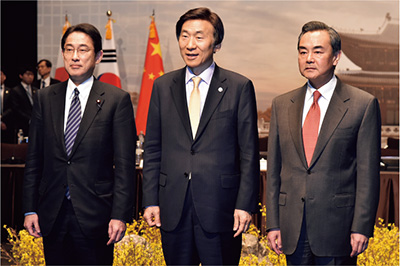 The Japan-China-ROK Foreign Ministers’ Meeting
The Japan-China-ROK Foreign Ministers’ Meeting(March 21, Seoul, Korea)
C. Japan-Taiwan relationship
The relationship between Japan and Taiwan is maintained on the basis of working relations at the non-governmental level, in accordance with the 1972 Joint Communiqué between Japan and China. For Japan, Taiwan is a crucial partner and an important friend, with which it shares basic values in the form of freedom, democracy, basic human rights, and the rule of law, as well as close economic relations and people-to-people exchanges.
Against this backdrop, the working relationship has been deepening, and in 2015, cooperation arrangements were signed between the Interchange Association and the Association of East Asian Relations covering a variety of field, including the avoidance of double taxation and the prevention of fiscal evasion with respect to taxes on income and the application of competition laws.
Since the import restrictions on Japanese food products were strengthened in Taiwan in May, the Japanese side repeatedly requested the Taiwanese side through the Interchange Association for abolition and relaxation of the import restrictions that are not based on scientific evidence.
Taiwan also asserts its own claim to the Senkaku Islands and there have been moves by civilian activists to land on the islands, as well as cases in which vessels belonging to the Taiwanese authorities have navigated in the waters surrounding the Senkaku Islands. However, none of these situations have escalated to the extent where they affect Japan–Taiwan relations in general.
(3) Mongolia
A. Domestic affairs
In August, a large coalition of the ruling Democratic Party / Justice Coalition (composed of Mongolian People’s Revolutionary Party (MPRP) and Mongolian National Democratic Party) and Mongolian People’s Party (MPP), an opposition party, was cancelled. This is because the Democratic Party broke the cooperation agreement it had entered into with the MPP, due to unfair dismissal of more than 600 national civil servants by ministers of the MPRP and sabotage by members of the same party at the State Great Hural (Parliament of Mongolia). Although President Tsakhia Elbegdorj called for continuation of the coalition, Chairman Zandaakhun. Enkhbold of the State Great Hural convened an extraordinary meeting to appoint new ministers. Accordingly, with six new ministers appointed, the 2nd Saikhanbileg cabinet consisting of the Democratic Party and the Justice Coalition alone was launched in September. The 2nd Saikhanbileg cabinet aims at a “government able to determine quickly” with continued emphasis on economic policy in the sluggish economic and financial situation.
The Mongolian economy was greatly depressed after recording a GDP growth of 17.3% in 2011, caused by a fall in global resources prices and the sluggish Chinese economy, as well as a decrease in foreign direct investment due to the restrictive policy for foreign investment into Mongolia against the backdrop of its resource nationalism and the enactment of such laws. The GDP continued double-digit growth from 2011 through 2013, and then fell to 7.8% growth in 2014. In 2015, the economy is expected to grow at about 4%.
B. Japan-Mongolia relations
Japan will continue to strengthen friendly relationship as the “Strategic Partnership” with Mongolia, which shares fundamental values, such as freedom and democracy, and market economy.
In 2015, high-level exchanges were actively carried out following the previous year. Mongolian Prime Minister Chimed Saikhanbileg visited Japan (February), followed by Chairman Zandaakhuu Enkhbold of the State Great Khural (February) and President Tsakhia Elbegdorj (May). Prime Minister Abe visited Mongolia in October as the first Japanese incumbent prime minister visiting Mongolia twice. In particular, on the occasion of Prime Minister Chimed Saikhanbileg’s visit to Japan, the Japan-Mongolia Economic Partnership Agreement was signed, the first such agreement for Mongolia. When Prime Minister Abe visited Mongolia, the 8th summit meeting was carried out between Prime Minister Abe and President Tsakhia Elbegdorj. Furthermore, a number of ministers visited Japan from Mongolia, such as the Minister of Industry, Minister of Population Development and Social Protection, Minister of Justice, Minister of Health and Sports, and Minister of Food and Agriculture.
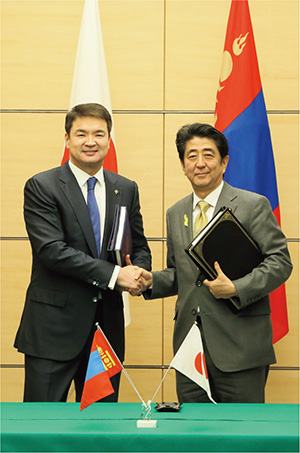 The two leaders shaking hands after finishing the signing ceremony for the Japan-Mongolia Economic Partnership Agreement (February 10, Tokyo; Photo: Cabinet Public Relations Office)
The two leaders shaking hands after finishing the signing ceremony for the Japan-Mongolia Economic Partnership Agreement (February 10, Tokyo; Photo: Cabinet Public Relations Office)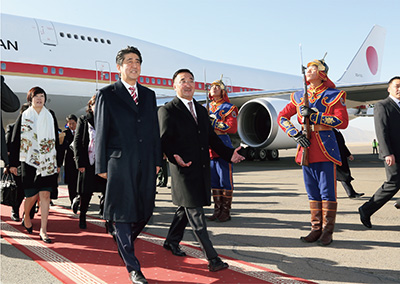 Prime Minister Abe’s visit to Mongolia (October 22, Ulaanbaatar, Mongolia; Photo: Cabinet Public Relations Office)
Prime Minister Abe’s visit to Mongolia (October 22, Ulaanbaatar, Mongolia; Photo: Cabinet Public Relations Office)In New York, the first consultation among diplomatic authorities of Japan, the U.S. and Mongolia was held in September as a new attempt, wherein they exchanged views on a broad range of fields including the economy, multilateral and regional cooperation and regional situation.

